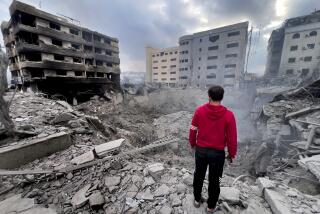Remember Beirut? Welcome to Baghdad
Even before the Iraq war began, supporters and opponents engaged in a war of analogies. Supporters invoked the battle against Adolf Hitler or, more humbly, the “humanitarian interventions” in Bosnia and Kosovo, while opponents warned of a Vietnam on the Euphrates. After Saddam Hussein’s swift downfall -- amid scenes of Iraqi euphoria, some genuine, others subsequently revealed to have been choreographed by the U.S. military -- Paul Berman, a noted liberal hawk, likened the moment to the Prague Spring of 1968.
When the U.S. occupation encountered stiff armed resistance and the Pentagon screened “The Battle of Algiers,” both supporters and opponents rushed to see Gillo Pontecorvo’s classic film on the Algerian struggle against French colonialism, although they drew starkly different conclusions as to its lessons. But, for a variety of reasons -- beginning with the fact that the resistance was largely confined to the suddenly disenfranchised Sunni minority, with the Shiite majority grudgingly accepting the American presence thanks to the counsel of their spiritual leader, the Grand Ayatollah Ali Sistani -- the Algerian parallel became another casualty of the war of analogies.
For the record:
12:00 a.m. March 10, 2006 For The Record
Los Angeles Times Friday March 10, 2006 Home Edition California Part B Page 13 Editorial Pages Desk 1 inches; 54 words Type of Material: Correction
Iraq: An article Saturday on Baghdad and Beirut said writer Paul Berman compared the fall of Saddam Hussein to the Prague Spring of 1968. It should have said Berman compared Hussein’s fall to Prague in 1989, as reported in George Packer’s book, “The Assassins’ Gate.” Berman says, however, that he never made the comparison.
Today, with Iraq on the brink of civil war between Shiites and Sunnis -- and the Americans looking increasingly helpless, their mission having shifted from “democratization” to peacekeeping -- another analogy has been circulating in policy circles: the Lebanese civil war. Like any analogy, it’s not perfect, but it’s the best we have so far.
Like Lebanon, Iraq is an extraordinarily diverse country, a mosaic of religious and ethnic groups cobbled together by an imperial power almost a century ago. As in Lebanon during the civil war (which ran from 1975 to 1991), Iraq’s communities, which once coexisted peacefully (although not on equal terms) have assumed an increasingly sectarian character, leaving the country without a center.
The void created by the collapse of the Iraqi dictatorship has been filled, as in Lebanon, by sectarian militias and/or guerrilla armies, which, in offering protection to frightened Iraqis, have turned religious differences to political advantage. As in Lebanon, these armies enjoy a measure of sponsorship from foreign parties (Americans, Iranians, jihadists-without-borders, et al) that sense, correctly, that the future of the region is at stake.
Even the violence eerily recalls Beirut’s worst days: suicide bombings in marketplaces and sites of worship; revenge killings by religious militias; kidnappings and killings of Western journalists.
Every war is, of course, unique, and the Lebanon analogy only goes so far. In Lebanon, for instance, sectarianism is a veritable political tradition, a form of power-sharing with deep roots; in Iraq, sectarianism is more recent, resulting from the Baath Party’s perpetuation of Sunni dominance under the guise of Arab nationalism and from decisions taken by the U.S. occupation authorities -- notably an unnecessarily punitive de-Baathification program that, in Sunni eyes, was indistinguishable from de-Sunnification.
Where the division in Lebanon was between Muslims and Christians, in Iraq it is between Sunni and Shiite Muslims. And while Lebanon has a desirable port, it does not have Iraq’s oil. And the Iraq war -- both the American invasion and the struggle between Iraqi sects that the occupation has unleashed -- has always been, in part, about control of the country’s vast reserves of crude.
Still, the parallels with Lebanon are close enough to be instructive. The Iraq war has, from the beginning, bolstered the aspirations of Iraq’s long-persecuted Shiite majority, whose struggle has a strikingly relevant precedent in Lebanon. It was, after all, a series of foreign interventions -- the 1982 Israeli invasion, which left thousands dead, many of them Shiites, and the American and French peacekeeping operations that followed -- that awakened Lebanon’s Shiites masses, the country’s largest sect.
Young Lebanese Shiites formed the guerrilla movement Hezbollah, with arms and ideological inspiration from Iran (with help from exiled members of the Daawa, an Iraqi Shiite opposition party whose leader, Ibrahim Jafari, is now Iraq’s prime minister).
Western intervention gave Lebanon’s Shiites a cause by which they could demonstrate their Arab nationalist credentials. They succeeded with ruthless determination. A series of Hezbollah suicide bombings against American and French targets left hundreds dead -- and drove Western forces out of Lebanon. Then, with Iranian and Syrian backing, Hezbollah fought a disciplined guerrilla war against the Israeli occupation of the south, ultimately forcing Israel to withdraw in the spring of 2000 -- an event widely hailed as the first Arab victory against the Jewish state on the battlefield.
Hezbollah shrewdly converted its victories into political capital, becoming one of Lebanon’s largest political parties, with the result that the country’s Shiites can no longer be ignored by Sunni and Christian elites.
With its arsenal of Katyusha rockets, which serve as Iran’s shield against an Israeli preemptive assault on its nuclear facility, and its ties to Palestinian Islamists, Hezbollah has also given Tehran the foothold in the Arab east it so ardently sought.
Now, the American war has empowered Iraq’s Shiite religious parties in much the same way. In Iraq today, we may be witnessing the third stage of a regional Shiite resurgence that began in Iran in 1979 and spread to Lebanon in the 1980s. Although the United States may have invaded Iraq in part to contain the ambitions of Iran, it has in fact emboldened the Islamic republic by defeating its cruelest adversary -- and ensuring that the “new” Iraq will be a Shiite regime, if not a client state of Tehran. As in Lebanon, the West has played the role of midwife to revolutionary Shiism.
The Shiites are not a monolith, and Iraq’s Shiite parties are not directed from Tehran. Unlike Hezbollah, Iraq’s Shiites (with the notable exception of Muqtada Sadr’s Al Mahdi militia) have tacitly cooperated with the American forces, but not because they have any love for the Americans. The U.S. is deeply distrusted for having encouraged the 1991 Shiite uprising, only to abandon it to Hussein’s Revolutionary Guard, and the American occupation of the last three years has not overcome these suspicions.
If the U.S. has avoided violent confrontation thus far with Iraq’s Shiites -- and if, until the Feb. 22 bombing of a sacred shrine in Samarra, the Shiites avoided responding to the abundant and appalling provocations of Sunni guerrillas -- it is because of the restraint urged by Sistani.
But the Shiite retaliations for the outrage in Samarra, which left hundreds of Sunnis dead, revealed that restraint is losing ground on the Shiite street, and Sistani’s warning that “the believers” may be forced to defend themselves suggests that his own patience is wearing thin.
If the war between Sunni jihadists and Shiite militias escalates -- and Sistani, an honorable man who is also a calculating politician, throws his weight behind a militia, or creates his own -- full-scale civil war is almost certain to explode. Should this come to pass, the Lebanonization of Iraq will be realized, and the Americans who lighted the fuse will be unable to extinguish it.
More to Read
Sign up for Essential California
The most important California stories and recommendations in your inbox every morning.
You may occasionally receive promotional content from the Los Angeles Times.










